 Satellite Antennas Hints and Kinks
Satellite Antennas Hints and Kinks Satellite Antennas Hints and Kinks
Satellite Antennas Hints and KinksThe following article was originally presented at a Project OSCAR seminar on September 30th, 1990. AMSAT-UK printed an abridged version of this presentation in their OSCAR News, Number 88, April 1991. The original presentation has been reedited and updated for AMSAT's Web page.
Years of home brewing has taught me how to do and not to do a lot of things properly. This experience, along with reading AMSAT- NA, AMSAT-UK and ARRL publications (Note 1) has taught me how to build my projects better. Here are some tips I learned that may be of help with the most important part of an amateur radio satellite station, the antenna systems.
Materials to build satellite antennas can sometimes be found among junk most people would throw away. An old broken-off car radio antenna I found lying in the street became the vertical element of a two meter 5/8 wave groundplane for mode A and T. Four wire clothes hangers became the radials. Likewise all the remaining components were "salvaged" from other junk I had collected here and there. I used this simple matching network:
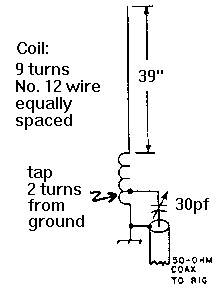
All you need to build a simple VHF or UHF 1/4 wave groundplane antenna is a coax chassis connector and number 12 or larger wire scraps. Solder the vertical element to the center conductor and attach the radials with nuts and bolts to the four corners, then solder each corner. Make the vertical element a bit longer than calculated and bend the radials down 25 to 30 degrees a short distance from the connector flange. Then trim the vertical element (in small increments) for the minimum SWR at the low end of the band in which it will be used. When the SWR begins to go back up, it should be lowest near the center of the band. If not, trim carefully until it is. Then little by little bend the radials down until you get a 1 to 1 SWR. This will be between 30 to 45 degrees, as shown below.
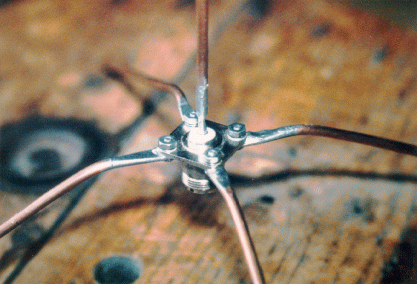
Number 8 wire was used. Ends were hammered flat, filed to shape and drilled. A small propane torch, used carefully so as not to overheat the connector, will make the soldering easy. Flux paste on the connector's flange will aid solder bonding. The vertical element's end was filed down until it fit inside the center pin connector. Waterproof the coax connector so water cannot seep into your coax.
Old weathered, corroded junked ham beams are another excellent source of recyclable antenna materials. I salvaged an old phased pair of inoperative Cushcraft two meter beams that were covered with corrosion and rust and were destined for the trash dump. Removing the rusted and corroded hardware was easy after a brisk wire brushing and soaking all the hardware with WD-40 (a penetrating oil) over night. After disassembling all the aluminum elements from the boom, I gave the boom and elements a good soaking and brushing in an acid bath. Acid solutions made specially for cleaning aluminum are available in well-stocked hardware stores. I now had clean looking elements and booms. A little time sanding out the corrosion pits with fine wet sandpaper and the elements and boom were as good as new.
I then drilled pilot holes on one boom 90 degrees and about an inch (2.5 cm) from the existing element holes. Upsizing the pilot holes to the diameter of the elements and securing all the elements with new sheet metal screws one size larger than the original size (so these new screws were tight in the old holes) tied them all together.
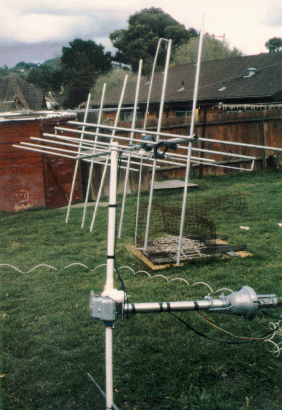
For the price of an acid bath and a few stainless steel nuts, bolts and sheet metal screws, a new two meter crossed yagi was born. Do not cut expenses with hardware. Always get stainless steel hardware for structural connections. Brass hardware can be used for electrical connections where there will not be much mechanical stress. The extra expense will be paid back with interest in a few years when it comes time for antenna maintenance.
Likewise I recycled a friend's junked ancient Hy-Gain trap tribander. After removing all the corroded and rusted hardware and traps and giving the elements a good acid bath, brushing and sanding, I had the makings (for free) for either a 15 or 10 meter beam for modes A, K or T. Essential rusted steel parts, like the boom to element brackets, were wire brushed and painted. As mode A was my objective, this beam came back to life as a full size three element 10 meter beam.
After years of trying various products and techniques to eliminate rust once it is well established, I have found a way that really works. First wire brush the metal with a wire brush wheel attached to either your bench grinder (the best way) or power drill until it is shiny. A base coat of Rust-Oleum (tm) Rusty Metal Primer (7769), then a coat of Clean Metal Primer (7773) and two coats of Aluminum Metallic Finish (7715) will keep your paint from blistering and the rust from reappearing for many years. Be sure to use Rust-Oleum thinner as needed to keep the paint at the proper viscosity so it brushes or sprays on properly.
Antenna wire left over from an 80 meter dipole project became the element for my 10 meter horizontal delta loop, which keeps my mode A downlink strong on the overhead portion of my mode A passes. By hanging it only 15 feet (4.5 meters) high with the feed-point near my shack's window I was able to feed it with a short scrap of coax left over from a 50 foot roll I bought for another antenna project. A quarter wave transformer section of 75 ohm RG-59/U coax from the delta loop's feed point to my 50 ohm coax feedline was an easy to make match (Note 2).
The 70cm Lindenblad antennas I described in AMSAT Journal and OSCAR News articles (Note 3) were built totally from scrap plastic and wire I already had. They were mounted on a pair of old broom handles that I knew I'd have a use for some day, as shown below. This is the best omnidirectional antenna I have ever used as the ability to switch polarizations minimizes QSB and maximizes signal strength.
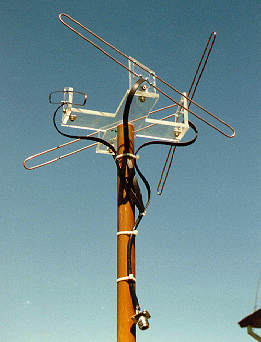
I have had good luck with folded dipole driven elements as they are easy to design and match and have a "flatter" SWR curve than dipoles. The chart below shows the impedance step-up ratio for a two-conductor folded diple, as a function of conductor diameters and spacing. Dimensions d1, d2, and S are shown in the inset drawing. The formula for the step-up ratio, r, is also shown. Besides checking your SWR, check your power output from your matching network, as a bad matching network may give you a good SWR while dissipating RF as heat. I discovered an antenna feedpoint toroid balun that had a power loss I found unacceptable, so I replaced it with one of the lower loss balancing method discussed in the ARRL's Antenna Handbook (Note 2).
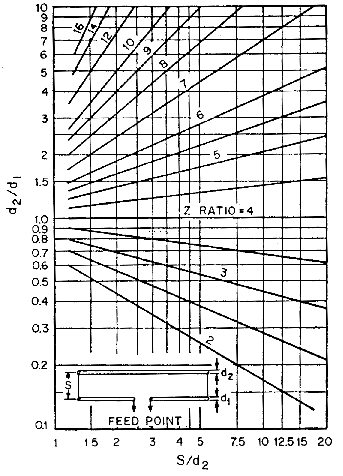
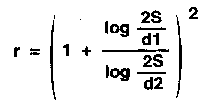
Circular polarized antennas capable of being switched from right to left handed circular polarization will give you the best performance, as polarization can change directions during a pass. The drawing below shows how to do this with 52 ohm antenna feed points. When calculating the length of individual cables be sure to include the velocity factor of the cables.
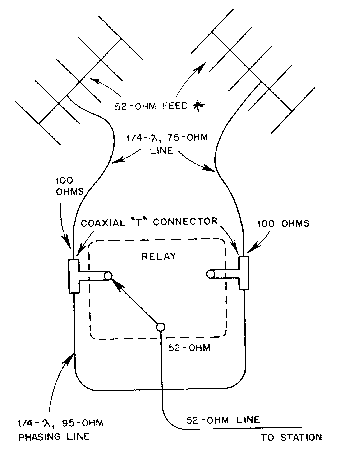
If you use folded dipole driven elements you can modify the design for a 400 ohm feedpoint impedance by using the cabling as shown above, but replace the quarter wave of 75 ohm coax from the coaxial "T" connectors to the dipoles with two eqaul convenient lengths of RG-62/U (93 ohm) or RG-133/U (95 ohm) coax. The half wave coaxial balun shown below will give you a 4:1 impedance step-up so you will have a good match to a 400 ohm folded dipole feedpoint. Although it is not necessary, purists can tweak the folded dipole's spacing until the SWR meter's needle does not move off the peg.
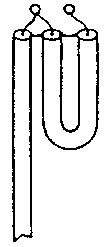
Whenever you make a coax balun always make it a bit longer than the calculated length. Do not forget to include the coax velocity factor in your calculations. Use a dip-meter to determine its resonant frequency, trimming it until it is tuned to the center of your band of operation, as shown below. I have made several coax baluns and the actual electrical length has never been exactly what the calculations said it should have been. My low SWRs always confirm the dip-meter length was right.
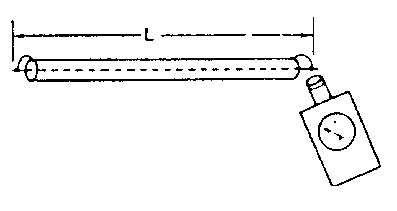
The antenna should be as close as possible to where it will be permanently installed when you tune for the minimum SWR. A low SWR on a tall step ladder in your back yard (so you can tune it easily and have the SWR sensor attached to the antenna's coax feedpoint) may be fine for a rough cut tune after assembly. But it may need to be retuned again when in place on its mast or tower. It is usually not practical to get at your antenna's feed point once it is permanently raised and mounted. But how can you compare an SWR taken with the sensor on the antenna's feed point with an SWR when the sensor is connected to your antenna at the far end of a long run of coax? The chart below does this job nicely.
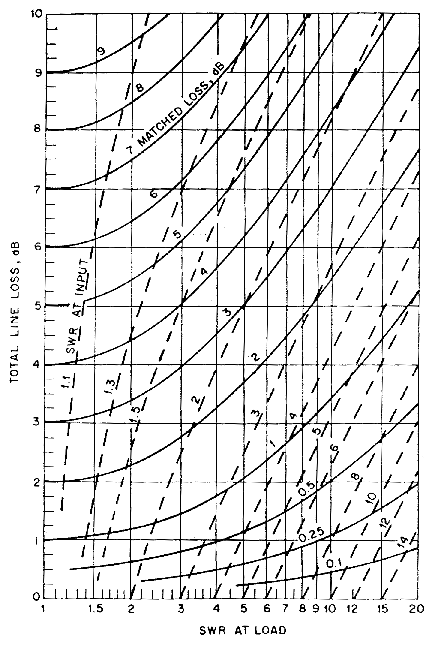
How do you know for sure what your total line loss is for this chart? Use a coax attenuation chart? No way! You should test and log (in your station's log book) the loss of every coax section between your rig and antenna at the highest frequency it will be used. Test even those short 1 or 2 foot (30 to 60 cm) coax interconnection jumpers, and add them all together to get your actual total line loss.
Test each section with your SWR/power sensor first on the transmitter end, note your SWR (it should be 1:1) and your power in. Then put your sensor on the dummy load end. Note your power out and calculate your dB loss for each section. If you have never done this you may be in for some surprises. This is what convinced me to convert all of my 2 meters and higher coax lines to "N" connectors.
Don't forget to test accessories used in line with your coax. A local ham told me he found his brand new "N" connector coax switch had almost 6 dB of loss. I bought a new "PL-259-to-N" adaptor that I discovered had a similar loss.
Beware of cable marked RG-8/U TYPE (and other RG-* TYPE coax) as this means it does not comply to the specs for RG-8/U (or other RG-* specs) as far as loss and velocity factors. I bought some RG-8/U TYPE coax from a well known "cheap electronics" chain store that had unacceptable impedance bumps (detected as a high SWR) at splice points (those periodic bulges in the coax). Also the "good" sections had higher losses than shown in coax attenuation charts.
This same store sells cheap coax connectors that have higher impedance bumps (SWR) and losses than my Amphenol connectors. And when I tried to solder groundplane radials to this store's coax chassis connector, the center pin insulation melted and fell out of the metal case. Quality coax connectors now use teflon insulation which has low loss at high frequencies and has a high melting temperature. So beware of "cheap" coax and connectors, as you usually get what you pay for.
Some quality "RG-8/U TYPE" coax may be better than the specs, such as the coax Belden and other quality coax manufacturers produce. These companies publish their specs so you can compare them with the standard "mil-spec" coax. Take your handitalkie, SWR/wattmeter, dummy load and coax connector adapters with you when you go surplus shopping to see if that used coax or accessory is still good before you buy it.
The hassle of making special balanced dummy loads (to test baluns and matching sections) and taking the time to test all your coax sections and in-line accessories will pay for itself if you discover problems like those I discussed. In satellite work, every dB counts. Also, by adding up your total feed system loss and doing some simple calculations with your antenna gain figures you will be able to figure what your true EIRP is.
More practically, it will be a snap to trouble shoot any signal strength loss in the future. You will know what signal loss is normal. When you suspect your line loss has increased, measure the loss from your receiver to some convenient mid point, like where the coax leaves your room. If that loss is as expected, you know your trouble is between that point and the antenna. Repeat this "divide and conquer" search by testing the loss between the room entry and some mid point, like a preamp, and you will quickly locate the lossy component. Also you will know when it is time to change your coax by its increased loss, not its age.
As the name of the game with satellite transmission lines is low loss, I have become fond of Belden's 9913 coax. Sure, hardline is better, but 9913 is easier. Once you pick up a few tricks and skills you will agree that installing "N" connectors on 9913 is much easier (and less lossy) than using the standard so-called "UHF" PL-259 connectors. To make a successful "N" coax connector fitting you must:
Cut your coax a few inches longer than you need so you will feel free to cut off a fitting you are not happy with and try again until you get it right. Use what is referred to in ARRL publications as the "improved clamp" (like the Amphenol 82-202-1006) as it is easier to fabricate. Detailed fabrication illustrations with exact dimensions can be found in publications like The ARRL Handbook, The ARRL Antenna Book and The ARRL Electronics Data Book.
Stiff 9913 does not wear well where it must flex a lot, like where your coax leaves your boom up to your fixed attachment point on your mast or tower. Here a short run of RG-8/U will do better. If you already use 9913 for these flexing areas, you will eventually find kinks appearing at the points of most bending stress. This can be rectified by cutting 3 staggered lengths of RG-8/U that will go from the boom to beyond the kink. Secure them to the boom and the flexing 9913 with tape so they will take the bending stress and "round" the bend radius. Make these coax stiffeners long enough, with each piece at least an inch (2.5 cm) longer than the previous one so you are not soon faced with a new kink where the RG-8/U stiffener section ends.
My first circular polarized beam had the coax routed forward along the antenna boom to the elevation rotor boom up to the mast, where I had a small flex section. It is claimed that your circular polarization pattern is better if the coax is not attached along the boom but instead hangs from the boom's rear end and loops forward to the main mast. I did it this way on my next two beams. But I found no noticeable difference in performance on the air (where it counts) between these two coax routes. This is probably because we rarely get a perfectly circular polarized downlink signal. But I did notice more flexing problems with a long 9913 coax loop off the rear of the booms. A poorly made "N" connector may slip apart from the extra weight it must support on beams that have their coax connectors mounted 90 degrees to the beam's boom. Also I can no longer track an overhead pass horizon to horizon by tracking 180 with the elevation rotor. I am now limited to 90 degrees elevation and must change the azimuth heading 180 degrees at mid pass.
Although "N" connectors are said to be waterproof, I still feel better wrapping the connectors with sealing tape, like Coax-Seal (tm) which you then can mold after wrapping to exactly the way you want. This moldable tape is great for any coax weatherproofing, such as coax balun ends or feed points. Use several layers so the surface cracking that will occur with age will not go all the way through to the coax and connector. Linerless rubber splicing tape made for electricians by Scotch 3M (tm) is better for coax fittings, as it will not crack with age and is not so messy to remove. The overlapping rubber splicing tape flows together as it cures to become a solid rubber covering that needs to be slit lengthwise and peeled off to remove. Silicone outgases corrosive vapors that hasten shield corrosive damage. This will shorten the lifetime of your coax connectors.
Secure your coax, rotor lines and control cables with self locking plastic "zip" ties that are made for outdoor use, and are UV resistent. They are usually black. The white ties commonly used are for indoor use only. They will eventually break on their own if used outdoors. I like to use these ties at the end of my tape wraps to keep the end of the tape from lifting up with age.
Computer birdies can ruin your best low loss run from your beam. The more sensitive your system, the louder these birdies get. Check to be sure all your computer and TNC cables are shielded with the shields attached to ground. I bought a "bargain" computer cable that did not connect the DB connector's mechanical ground shell to the cable's shield. Place wide copper or aluminum tape over all cracks, openings and poor fitting shielding inserts on your computer (like the metal strips for cable connectors on the rear of PC slot cards).
Most computers have a well vented and poorly grounded cabinet. Check out your cabinet and scrape the paint off all mating surfaces and under cabinet screw heads. Buy some copper screen and cut out pieces to go over all vent openings and the fan exhaust hole. Leave enough overlapping screen so you can easily mount the screen inside the cabinet. Run a solder bead along the screen's edges and reinforce ground attachment points where the screen can be screwed to existing cabinet screws. Add ground mount screws if you cannot secure the screen with existing cabinet screws.
After making a good ground system for your station, if you still have a problem with birdies, check everything connected to ground. Disconnect the ground straps one at a time to see if any ground connection will make your computer birdies decrease. I found one device that reduced my remaining birdies significantly when DISCONNECTED from my station's main ground strap bus. It was also connect to ground via coax connectors shields, so there must have been a ground loop radiating the birdies. These efforts have left me only two very faint computer birdies that are rarely encountered and easily covered by downlink signals when they are.
You should have EMI AC filters on your computer and rigs AC outlet or line. If you still have problems with birdies, disconnect each cable and line one at a time to determine what line is radiating your birdie. Wrap the offending cable several times through a toroid core on the end where the birdie is being generated to choke off the RFI flowing on this line's shielding.
Desense problems awaits most mode JD and JA users. Although a quarter wave shorted coax stub will null out the offending 2 meters uplink signal, its loss on the downlink signal is unacceptable to me. The cavity desense filter does a better a job with no noticeable attenuation of the downlink signal. Have the plumbing store where you buy the copper pipes cut them for you. Be sure to make it clear that you need a precisely sized pipe that is cut without excessive blade pressure that might flare in the pipe ends.
Automatic antenna tracking is great, but the clacking of the relays inside your rotor control box every time the beams move is annoying. The circuit shown below does this switching silently. I sent this circuit to Brooks (of Kansas City Tracker) and he said this is how he does it at his station. He said he does not suggest this in his manual out of concern for liability in case people build it incorrectly and electrocute themselves or fry their computer. So be careful if you make this circuit and test it carefully when you are done. A fault can be lethal to you or your computer. Do not build it if you are not familiar with standard electrical safety construction practice. Consider yourself warned!

A low cost self supporting 40 foot (12 meter) mast can be made from a common 50 foot (15 meter) telescoping guyed TV mast. This is my double zepp antenna support mast, which I use for my 15 meters modes K and T uplink, a well as on all of the HF bands.
Extend each 10 foot (3 meter) section 5 feet (1.5 meters) and redrill the locking pin holes through both masts to secure them at half mast with a large stainless steel bolt, washer, lockwasher and nut. Mark a dark vertical line where the two masts telescope together so you can see how they should be positioned for the holes to line up. Then you will not have to hunt for the holes later when raising the masts. Use the circular clamp locking bolts that are at the top of each mast section to tighten out the slop between masts. You will end up with a self supporting 30 foot mast. I purchased two more 10 foot (3 meter) mast sections to similarly telescope into the top mast to extend my mast to 40 feet (12 meters).
For a base I dug a post hole and positioned a pipe vertically in the hole that just fit inside the bottom mast section. I filled the hole with concrete, leaving 4 inches (10 cm) of this pipe above the top. The bottom mast section was placed onto this pipe stub and secured with a bolt similar to the upper sections. A sturdy wooden frame was fabricated that was structurally attached to my house about 10 feet (3 meters) above the ground. The top of the first 10 foot (3 meter) mast section was securely clamped to this frame. This brace also provided a convenient point to tie my ladder while raising and lowering my antenna mast, giving me a safe and solid structure to work from.
This self supporting mast whipped (but did not break) more than I liked during a strong wind storm so I added a set of mylar guys near the top to keep it (and my SWR) rock steady. But as guys are not needed normally, I can raise and lower it by myself for antenna maintenance. Stainless steel hose clamps secured to the top of each section will keep each section from going too far inside the lower section when lowered. This is a convenient place to secure your open line stand-offs.
Guy wires are often a problem, as metal ones need ugly egg insulators, and even then you may end up with an unexpected resonant section. Common synthetic ropes have a stretch problem. Fortunately mylar rope has been designed specifically for antenna guying. When you use the proper size line, it is as strong as steel guy wire and its stretch, even on long runs, is negligible. The owners and staff of United States Rope (Note 4) will be happy to discuss the specs of their mylar guy rope with you. I used a set of mylar guys for 10 years before I decided it was time to replace them. The sun's UV light eventually weakens them, but in my experience, not any faster than my galvanized guys rusted. United States Rope tested my 10 year old line and found that although it was getting weaker, it still met the service specs I needed, so it was not about to fail.
Getting supplies for antenna and other home brew projects can be a challenge. Check your telephone book's "Yellow Pages" for local electronics surplus stores. Sometimes "general" surplus and salvage stores will have an electronics section, or materials that you can use. Check local Universities and colleges as they often have public outlets where they dispose of their surplus electronic supplies and gear. Usually these sources are strictly "walk in" warehouses where sales staff will not know all that they have. Just wander around and look at all the goodies not normally available by mail or regular electronic suppliers. Cannibalizing cheap "junked" devices from these sources and from ham flea markets are good sources for "junk box" stock.
Additional sources for components for building projects can be found by going through the ads of ARRL and AMSAT publications. AMSAT and ARRL advertisers deserve your support as they help make these publications available at prices we can easily afford.
Article by Howard Sodja, W6SHP. HTML conversion by and feedback to KB5MU.